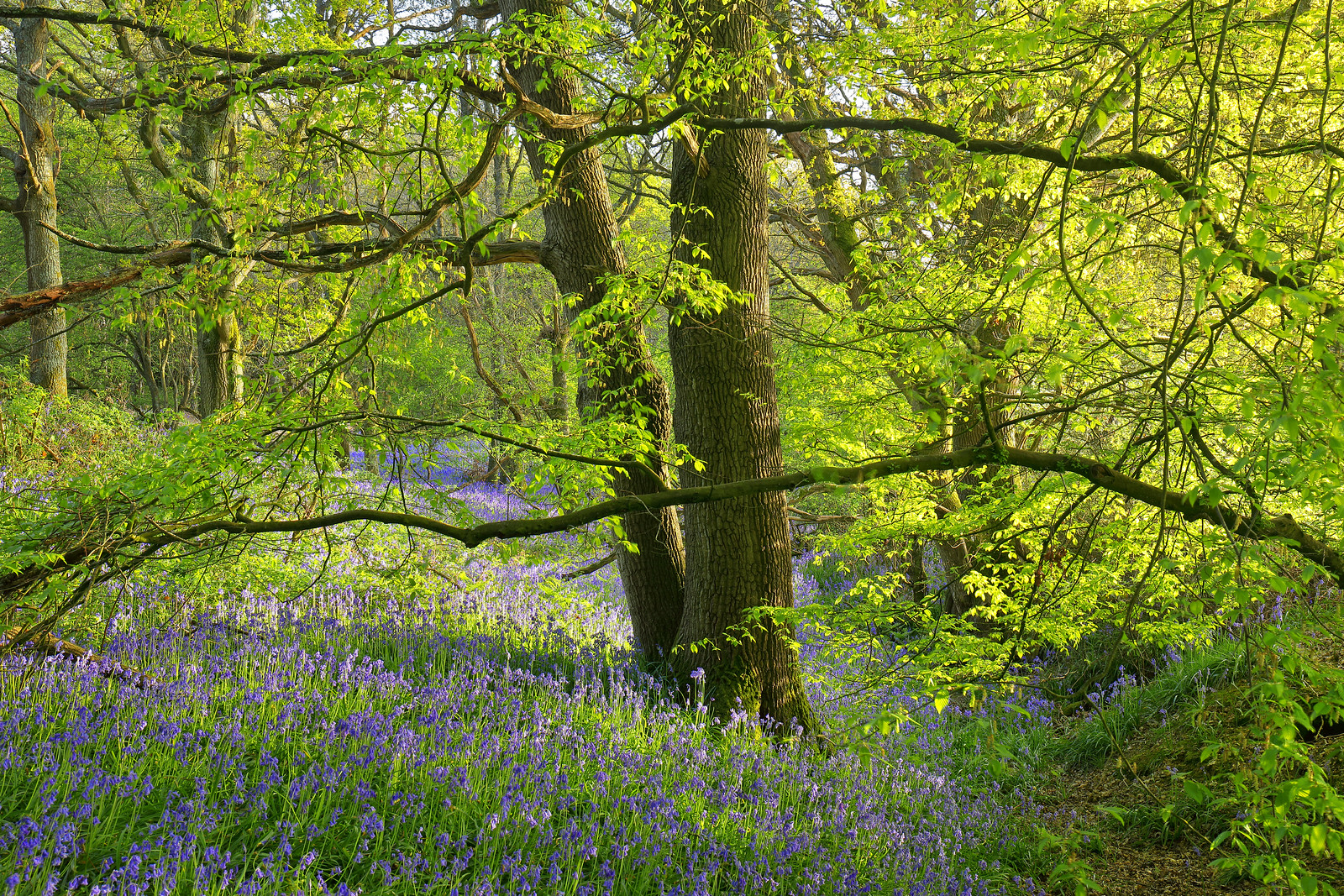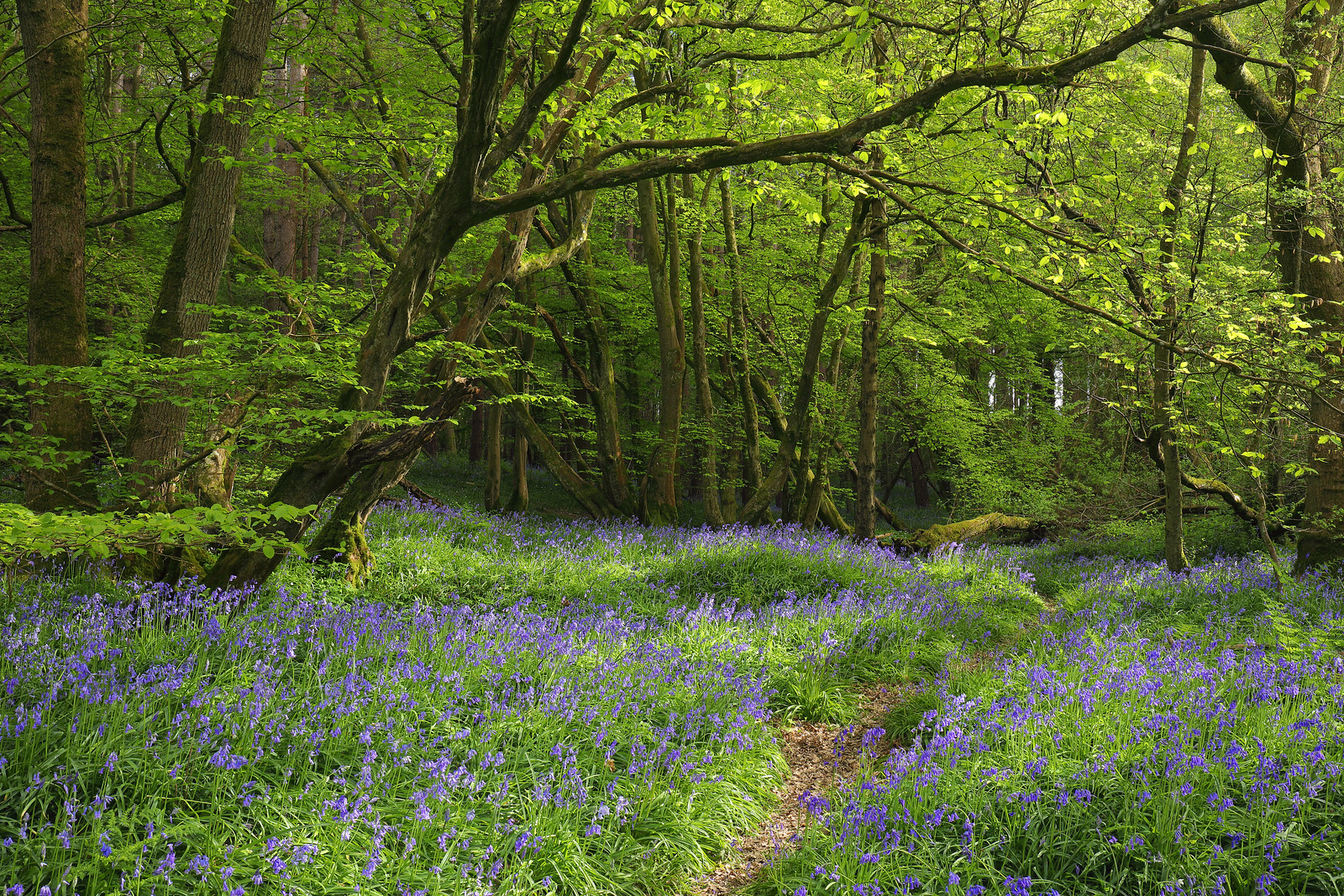The Secret Bluebell Woods of Sussex

The presence of dense bluebell carpets signifies that you are in ancient woodland. It can take hundreds of years of self-propagation for bulbs to reach the kind of densities seen across the British Isles in spring. They push up through the earth in late winter, taking advantage of leafless trees to photosynthesise, before flowering in late April or early May. Even as a supporter of the right to roam, visitors ought to be more careful to avoid walking on bluebells, something annoyingly visible on my walks every spring. Last year, I found a two-metre wide walkway, created by visitors, who had flattened a long section of bluebells, instead of using existing paths to reach points of interest. This year, when visiting another bluebell wood to the north of Brighton, I was dismayed to see an estimated 20 m sq triangle of bluebells flattened by walkers, along with widespread general damage.
If flowering bluebells were to be dug up, no bulb would be found. Without foliage to regenerate and nourish depleted bulbs, which channel all their stored energy into growth, damaged bluebells take five years to recover. I always take great care to find the least damaging route to a vantage point, using fallen tree trunks and bare patches to navigate over to a safe position. I spoke to a couple, who have been walking in a particular East Sussex bluebell wood for twenty years about the damage in a nearby popular site, and they said — "Thank goodness not many people seem to know about this place". Would people buy flowers from garden centres, plant them in the ground, and trample over the plants they just paid for? People can't be prevented from entering bluebell woods, but since the easily crushed bluebells only need to be damaged once, I would prefer not to share the locations.
The most common question strangers ask me on my walks, as people did this month, is do I enter my photos into competitions? I have entered photos in the past, that I considered to be very strong candidates, but they never got anywhere. There
is surely something wrong about giving influencial photographers, who are
probably not much better than I am, the power to select or discard my
work as they see fit. I have since pushed back against the pervasive Enlightenment worldview fixated on cause and effect, metrics and goals, and the idea that if something cannot be 'measured' or 'categorised' in a rational way, it is effectively irrelevant. No amount of 'likes', 'views' and 'awards' can account for the lived human experience of being immersed in bluebell woods. Photography is not an inherently competitive activity, unlike tennis or chess, but the infiltration of neoliberal ideology into all aspects of life over the past forty years has reshaped hobbies and pastimes into vehicles of accumulation, self-promotion and one-upmanship. I have personal experience of the attitudes displayed by 'award-winning photographers'. I'm simply not interested in the trappings of fame, nor could I in any case pursue it, due to my considerable personal responsibilities, but I feel it's my duty to blow the whistle on what is simply an un-meritocratic system. UK landscape and wildlife competitions and editorials are highly managed, and achieving success owes much to social connections. My sources for these claims is someone who has been a judge in major UK competitions and my own research.
If an ambitious photographer wants to get anywhere, they must 'network' — skills available to those from upper/middle class backgrounds. Like many other industries, photography is a revolving door between a 'specialised class' of elite editors, judges and photographers. There are cases where, professional photographers, meaning working class people who sell their images to pay their mortgages and buy groceries, get 'overlooked' by editors, who then publish images taken by their non-professional friends, who earn six-figure salaries in other sectors. Elite photographers all know each other and each shares the conviction that they deserve to be where they are, that they did it all themselves and class politics is conspiratorial nonsense. Although competition entries are 'anonymous' anyone with their ear to the ground can tell who took a particular image, based on location, subject, style and technique. If a gatekeeper judge wishes to advance the career of a photographer in their social circle, then it is easy enough for them to infer the identity of an entrant and advance the images to the shortlist and beyond. With parallels to Western 'managed democracies' preventing actual democracy from gaining foothold, elite photography is no meritocracy.
Like any managed system, a degree of openness is allowed. To sustain itself, the competition industry simultaneously pays lip service to openness by awarding commendations to new entrants, while taking money from eager participants and seizing copyrights. Another method is for editors and organisers to employ identity politics in order to make the status quo appear more 'diverse'. Elite
female photographers can, for example, hide their economic privilege by
shrouding themselves in corporate-friendly liberal feminism, thereby
presenting themselves as plucky underdogs within the top-tier of influence. Rather than abolishing their own power and influence, the 'specialised class' instead appropriates the latest 'boutique' social issues, from the comfort of their own neighbourhoods, but without being personally exposed to the associated risks from belonging to marginalised groups. Themes, takeovers and categories based on social issues may make people feel that change is taking place, but in reality, the same elite-controlled power structures remain.
What the professional managerial classes call 'disinformation' and 'conspiracy theories' are often just facts that they want suppressed. In Western countries, factual information is suppressed by simply ignoring it and superimposing a power-friendly narrative. Since my account is 'all in a day's work' to the elite of credentialists who run the industry, in the unlikely event that any of them read it, they would just 'move on' and ignore it. I hope this answers the questions of the many people who ask me about competitions.

The cool, wet, unsettled weather of April 2023 delayed the peak blooming period by over a week, in comparison to last year, when frequent warm, albeit dry weather created an early, short-lived peak. Look at the above image to see how tall and open the bluebell flower heads were. On May 1st 2023, all the bluebells at this vantage point were closed. Look below at the 2023 version, to see how I have used my understanding of weather and lighting to create a dramatic image, as a cumulus cloud moving in-front of the sun created a sharp division between shadows and highlights.
Finally, before I go, here are some tips for taking better bluebell photographs:
1. Find new vantage points and keep them a secret to protect the bulbs from damage. It's easy to get drawn into honeypot sites, but many of the photos shown here are located not far from sites extensively damaged by the public.
2. Pay attention to weather patterns over winter when planning the date to photograph bluebells. A mild, dry winter and spring, such as in 2022, will result in an earlier, shorter-lived display. Winter cold snaps, followed by a cool, wet April, as in 2023, leads to bluebell flowering lasting longer and peaking later.
3. Bright, but diffused lighting is highly effective, if you photograph bluebells during normal waking hours. Direct sunlight creates harsh highlights and shadows, which can be distracting and creates issues when post-processing. The sun filtering through thin, high level clouds, especially in mid-evening, creates a glowing, warm lighting effect on the bluebells and forest canopy (see first two images).
4. Using a circular polarising filter to eliminate glare improves the appearance of foliage, while adding a small amount of focal length compression in the region of 50 mm increases the apparent density of bluebell carpets.
5. Most people get carried away by the naked eye attractiveness of bluebell woodlands, and forget to employ basic techniques used when photographing regular subjects. Good images are often simple and orderly. If you look at the above image, I have used tree trunks and limbs to provide natural framing, and the footpath leads the viewer towards the 'destination' clump of trees still in the shade.
Thank you for taking the time to read through my post on ancient bluebell woodlands. I felt much better by the second week, although my holiday went alarmingly quickly, which I made up for with a final visit on May 13th. I doubt many people will see my post, but I rely on your support in the comments section and for defeating the corporate-state controlled algorithms by sharing my post widely.











Comments